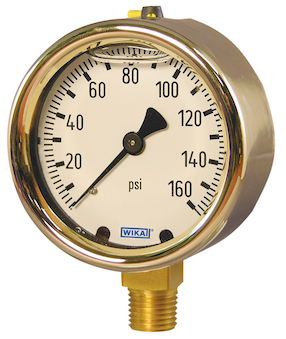
Liquid-filled gauges surpass dry gauges for two main reasons: performance and extended service life. Pressure gauges that are filled with a liquid, usually glycerin or silicone oil, perform better in less-than-ideal conditions. They are also more economical in the long run, as liquid-filled gauges suffer fewer breakdowns than dry gauges.
Why Pressure Gauges Fail
Pressure gauges are robust, but these mechanical instruments can fail with prolonged exposure to the following conditions:
- Mechanical vibration and pulsation
- Pressure spikes
- Humidity and moisture
The primary reason for gauge failure is vibration and pulsation. In a traditional dry gauge, prolonged mechanical movement can damage the instrument’s delicate links, pivots, and pinions. This wear and tear leads to inconsistent performance and, eventually, loss of functionality. Pressure spikes are also problematic, as the dramatic change can bend and even break the gauge’s pointer.
The best industry practice is to liquid fill the gauge. Case fill protects the gauge’s mechanisms by dampening system vibrations, pulsations, and pressure spikes. It also eliminates pointer flutter.
Humidity and moisture pose two main problems for dry gauges. First, condensation behind the gauge window, caused mainly by changes in ambient temperature, creates a fogging effect; this makes it difficult to read the dial. Second, remaining condensation inside the gauge will freeze at low temperatures and coat the delicate movement with a layer of ice; this will prevent the movement from functioning and eventually lead to a gauge failure.
Solution: Liquid filling prevents moisture from forming inside the case. Liquid-filled gauges are also sealed, further preventing internal condensation and protecting gauge movement during icing conditions.
Which Case Fill to Use in a Pressure Gauge
The choice of fill fluid largely depends on ambient temperature. In general, glycerin is used in moderate temperatures, not lower than −4˚F (−20˚C), while silicone oil is the case fill of choice for very cold temperatures down to −40˚F/°C. For even more extreme temperatures, check out WIKA’s POLARgauge® family, suitable for arctic ambient temperatures down to −94˚F (−70°C). Gauges with built-in electrical options, such as switches and transmitters, can also be filled using silicone case fill. The chemically inert Halocarbon oil is a good choice for use around oxygen, chlorine, and other reactive gases.
The Advantages of Liquid-Filled Gauges
In summary, liquid-filled pressure gauges offer numerous benefits over dry-case pressure gauges:
- Long-term cost savings. Viscous fluid filling lubricates the gauge’s mechanism. Over time, this option saves users money by reducing unscheduled downtime and prolonging the gauge’s service life.

Model 213.40 liquid-filled brass gauge
- Fewer failed gauges. Liquid fill protects against severe vibration, pulsation, and temperature fluctuations – major factors in the breakdown of dry gauges.
- Ease of reading. Without condensation buildup and pointer flutter, users have fewer difficulties in reading the gauge.
- Extra durability. Not only are liquid-filled gauges sealed, but some also have very rugged construction. Check out the 213.40, a Bourdon tube gauge featuring a cast-brass case and socket, making it ideal for heavy-duty service life.
Liquid-Filled Gauges from WIKA
While some customers are concerned about the extra cost of liquid filling for a pressure gauge, the long-term payoff is clear: Better protection against vibration, pulsation, corrosion, and moisture makes for a longer-lasting, more reliable instrument. WIKA’s liquid-filled gauges are highly durable, meaning lower cost and better accuracy over time. Our pressure portfolio includes a number of customizable process gauges, including instruments built for the demanding conditions of the oil and gas industry.
At the same time, certain industries should avoid instruments with liquid filling. For them, WIKA offers dampened movement industrial instrumentation and direct drive pressure gauges.
This WIKA video summarizes the advantages and applications of liquid-filled pressure gauges. For more information about choosing the right pressure solutions for your particular application and budget, contact WIKA USA’s pressure specialists.


Great information